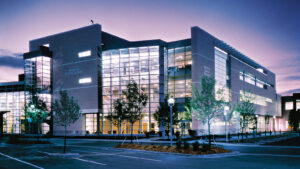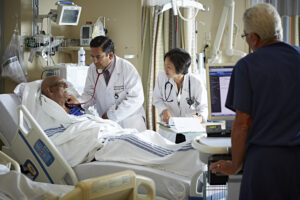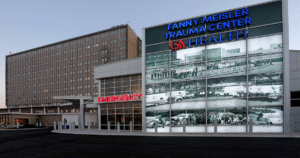More Than Medicine: A Day Inside USA Health University Hospital

You’re driving through a major American city, and you see it—a cluster of towering glass and steel buildings, interconnected by sky bridges, with a name emblazoned on the side that’s more than just a name: USA Health University Hospital. It’s not just a place where people go when they’re sick. It’s a universe unto itself. A citadel of hope, a factory of innovation, and a school for the world’s next medical pioneers, all operating under one, vast, humming roof.
Most of us hope we never have to spend much time there, but there’s a comfort in knowing it exists. This isn’t just a hospital; it’s an ecosystem where the lines between patient care, groundbreaking research, and teaching the next generation blur into a single, powerful mission: to heal, to discover, and to teach.
So, let’s step inside. Let’s peel back the layers and discover what really makes a place like USA Health University Hospital tick. This is the story of the lives it saves, the minds it shapes, and the community it holds.
The Beating Heart: Where Care and Discovery Collide
At its core, USA Health University Hospital is built on a unique and powerful model: the tripartite mission. This three-legged stool of Patient Care, Research, and Education is what sets it apart from your local community hospital. If one leg is weak, the entire structure fails. But when they are all strong, they create something extraordinary.

The Clinical Frontlines: World-Class Patient Care
Walk through the main lobby, and the first thing you notice is the controlled chaos. It’s a bustling Grand Central Station of healthcare. But behind the scenes, this is a place of profound expertise and sub-specialization.
1. The Department of Rare and Complex Diseases:
This is where patients arrive when their medical mystery has stumped everyone else. A 38-year-old woman with a constellation of symptoms that don’t fit a textbook diagnosis. A man with a genetic condition so rare, only a handful of cases exist worldwide. At USA Health, these aren’t dead ends. They are puzzles, and the hospital attracts the detectives who love to solve them. Teams of specialists—geneticists, immunologists, neurologists—gather in “case conference” rooms, whiteboards filled with arrows and question marks, collaborating to connect the dots. The community hospital might see one such case a year; here, it’s Tuesday.
2. The Center for Robotic and Minimally Invasive Surgery:
The image of a surgeon with a scalpel and a large incision is being rewritten here. In gleaming, state-of-the-art operating rooms, surgeons sit at consoles, their hands guiding robotic arms with precision measured in millimeters. For a prostate cancer patient, this means preserving nerve function. For a heart valve patient, it means a recovery time cut in half. This isn’t just about having the latest tech; it’s about the surgeons who helped design it, the fellows training on it, and the clinical trials running to improve its applications constantly. The patient on the table is receiving care that is, quite literally, at the cutting edge.
3. The Integrated Cancer Institute:
A cancer diagnosis is a terrifying journey, but at the USA Health Cancer Institute, you don’t walk it alone. From the moment a patient enters, they are assigned a navigator—a dedicated nurse who guides them through the labyrinth of appointments, tests, and treatments. The model is one of a “circle of care.” The medical oncologist, the radiation oncologist, the surgeon, the nutritionist, the physical therapist, and the mental health counselor all work in concert. They meet weekly to discuss your case, ensuring the left hand always knows what the right hand is doing. And because this is a university hospital, the treatments they offer often include immunotherapy drugs or targeted therapies that are not yet available anywhere else in the region, born from the research labs just a few floors above.
The Innovation Engine: Research That Transforms Lives
The phrase “bench to bedside” was coined for places like this. The research happening here isn’t abstract; it’s urgently practical.
The 9th Floor: Labs with a View:

Take the elevator to the 9th floor. Behind secure doors, you’ll find labs buzzing not with patients, but with the quiet, determined work of discovery. A postdoctoral researcher is analyzing the protein structure of a new virus. In another lab, a team is growing “organoids”—miniature, simplified versions of human organs—to test drug reactions without risking a single human life.
One of the most powerful stories is that of Dr. Aris Thorne, a cardiologist and researcher. For years, he was frustrated by the limitations of treating heart failure. In his lab, funded by a National Institutes of Health grant, his team has been developing a bio-engineered “patch” infused with a patient’s own stem cells. After a heart attack, this patch could be placed on the damaged tissue to help it regenerate. Last year, after a decade of work, the first human trial began. The first recipient was a 52-year-old teacher named Maria. The procedure was a success. Dr. Thorne’s research moved from a petri dish on the 9th floor to the beating heart of a patient in the operating room on the 3rd floor. This is the hospital’s promise in action.
The Learning Ground: Educating the Next Generation
The constant presence of students, residents, and fellows is the lifeblood of the hospital. They are the ones with the thick textbooks, the eager questions, and the fresh perspectives.
Rounds as a Classroom:
At 7:00 AM, you’ll find a team of residents, led by a senior attending physician, making their rounds. This is where textbook knowledge meets human reality. The attending, Dr. Evans, doesn’t just state the diagnosis. She turns to a young medical student and asks, “Sarah, based on the latest journal article we discussed, why did we choose this specific antibiotic for Mr. Davis?” It’s a Socratic dialogue in a hospital hallway. This constant questioning, this demand for evidence-based reasoning, ensures that every decision is scrutinized and every patient benefits from a collective brain trust.
This teaching environment also fosters a culture of humility and continuous learning. Attending physicians are expected to know the answers, but they are also expected to admit when they don’t. “That’s a great question. I’m not sure. Let’s look it up together,” is a common refrain. This creates an atmosphere where curiosity is valued over infallibility, which ultimately leads to better, more thoughtful patient care.
The Human Mosaic: Stories from the Halls
The true soul of USA Health University Hospital isn’t in its machines or its buildings; it’s in its people.
-

USA Health University Hospital Elena, the Charge Nurse on 7 West: With 15 years on the cardiac floor, Elena has seen it all. She runs her unit with a blend of fierce competence and deep compassion. She can calm a panicked family, mentor a flustered new nurse, and spot a subtle change in a patient’s condition that a monitor might miss. She is the steady, beating heart of her ward.
- David, a Second-Year Medical Resident: David is in the thick of it. He’s often on a 24-hour shift, surviving on coffee and the adrenaline of learning. He feels the immense weight of responsibility, the exhaustion, but also the profound privilege. He remembers the first time he delivered a baby, the first time a family thanked him for his care, the first time he had to deliver devastating news. These experiences are forging him into the physician he will become.
- Mr. Henderson, a Patient in the Clinical Trial: At 68, with stage-four lung cancer, Mr. Henderson had run out of standard options. His local oncologist referred him to USA Health. He enrolled in a Phase II clinical trial for a new targeted therapy. It’s not a guaranteed cure, and the side effects are challenging. But as he says, “I’m not just a patient here; I feel like a partner. The doctors are learning from me as much as I’m benefiting from them. If this doesn’t work for me, maybe what they learn will save my granddaughter one day.” His participation is an act of profound hope and altruism.
Beyond the Hospital Walls: A Commitment to Community
The mission of USA Health doesn’t stop at its front door. It recognizes that health is created in homes, schools, and communities, not just clinics.
The Mobile Health Unit: A large van, outfitted as a clinic on wheels, travels to underserved neighborhoods, offering free blood pressure screenings, vaccinations, and basic primary care. For many, this is their first and only point of contact with the healthcare system, a critical effort to bridge the gap in health disparities.
Community Health Workshops: Hospital experts don’t just wait for disease to arrive. They go out into the community, holding workshops in community centers and churches on topics like diabetes prevention, heart-healthy cooking, and managing stress. They are building a moat of prevention around their castle of cure.
Frequently Asked Questions (FAQs)
Q1: I’ve been diagnosed with a very rare condition. Why should I seek a second opinion at USA Health University Hospital instead of a great local hospital?
A: It often comes down to volume and collaboration. Your local hospital is excellent for most conditions, but for truly rare diseases, USA Health sees a high concentration of complex cases. Our specialists are sub-specialized, meaning they often focus on a very narrow field. Furthermore, the collaborative model means your case will be reviewed by a team of experts from different disciplines, and you will have access to clinical trials and treatments that may not be available elsewhere.
Q2: I’m nervous about being treated by a student or a resident. Is my care going to be compromised?
A: This is a very common and understandable concern. The short answer is no; in fact, the evidence suggests the opposite. You are never treated solely by a trainee. They work in a tightly supervised team model under the direct guidance of an experienced attending physician. This system of checks and balances means multiple sets of eyes are on your case. Trainees also bring a fresh, up-to-date knowledge base and the time to ask detailed questions, which can often uncover nuances that might otherwise be missed.
Q3: How does the research happening at the hospital directly benefit me as a patient today?
A: In countless ways. The drugs you are prescribed, the surgical techniques used, the imaging machines that scan you—many were developed and refined in university hospital settings. As a patient at USA Health, you have early access to the next generation of these tools. You might be eligible for a clinical trial that offers a new hope. The standard of care you receive here is often the one that will become the national standard five or ten years from now.
Q4: I’ve heard university hospitals are more expensive. Is that true?
A: The cost of care is complex and depends on your insurance. It is true that the advanced technology and specialized expertise required to treat complex conditions can be costly. However, it’s crucial to think about value, not just cost. Getting the right diagnosis and the most effective treatment the first time can prevent costly, prolonged, and ineffective care down the road. Our financial counseling team is also available to help patients navigate their options.
Q5: How can I, as a community member, support the hospital’s mission?
A: There are many ways! You can volunteer your time in patient-facing or administrative roles. You can participate in community fundraising events like walks or galas. You can donate to specific funds, whether for cancer research, pediatric care, or the uncompensated care fund that helps those who cannot afford it. And simply by being an advocate for public health and preventative care in your own circle, you are supporting our broader mission.

